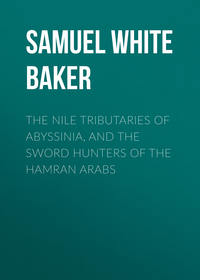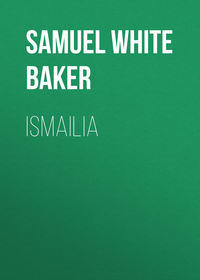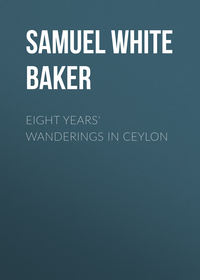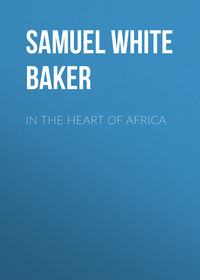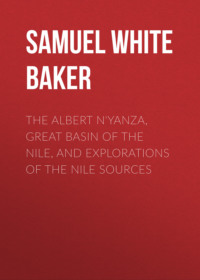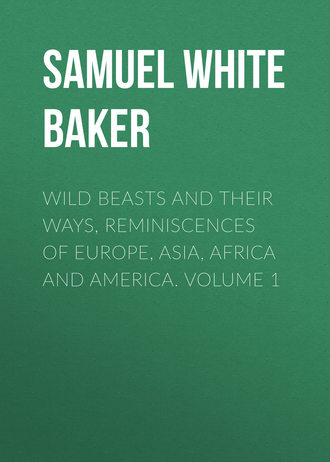 полная версия
полная версияWild Beasts and Their Ways, Reminiscences of Europe, Asia, Africa and America. Volume 1
Although the cubs of leopards are charming playthings, and exhibit much intelligence and apparent affection, it is a great mistake to adopt such companions, whose hereditary instincts are certain to become developed in full-grown life and lead to grave disaster. The common domestic cat is somewhat uncertain with her claws, and most people must have observed that should they be themselves spared the infliction of a feline scratch, the seats and backs of morocco chairs are well marked by the sharp talons, which cannot refrain from exercising their power upon any substance that tempts the operation. I remember a leopard in Khartoum that was considered tame; this beast broke its chain, and instead of enjoying its liberty in a peaceful manner, it at once fastened upon the throat of a much-prized cow, and would have killed the animal had it not been itself beaten to death with clubs by a number of stout slaves of the establishment. All such creatures are untrustworthy, and they should be avoided as domestic pets. The only class of leopard that should become the companion of man is the most interesting of the species: this is the hunting leopard (Felis jubata). I have never met a person who has shot one of this species in a wild state, and such an animal is rarely met with in the jungle. Most people are under the impression that the hunting leopard with non-retractile claws is incapable of climbing a tree; I was myself of this opinion until I actually witnessed the act, and the animal ran up a tree with apparent ease, ascending to the top.
The Felis jubata is totally different in shape from all other leopards. Instead of being low and long, with short but massive legs, it stands extremely high; the neck is long, the head small, the eyes large and piercing; the legs are long, and the body light. The tail is extremely long, and thick; this appears to assist it when turning sharply at full speed. The black spots upon the skin are very numerous, and are simply small dots of extreme black, without a resemblance of rings. It is generally admitted that the hunting leopard is the fastest animal in the world, as it can overtake upon open ground the well-known black-buck, which surpasses in speed the highest bred English greyhound. I have never had experience of this animal in a wild state; those I have known were as gentle as dogs. It is a common mistake to suppose that they invariably approach their game by a stealthy stalk, followed by a few tremendous bounds, only to slink back if disgraced by defeat. I have seen them run a long course in the open, exactly like a greyhound, although the pace and action have resembled the long swinging gallop of a monkey. The nature of this beautiful creature is entirely opposed to the cat-like crouching tactics of the ordinary leopard: its large and prominent eyes embrace a wide field of view; the length of neck and legs, combined with the erect attitude of the head, denotes the character of the animal, as it includes a vast distance in its gaze, showing that it seeks its game upon a wide expanse of plain, instead of surprising the prey by an unexpected and treacherous attack. This is the only species that is a useful companion to man when engaged in field sports; and the native princes of India have from time immemorial been accustomed to train the Felis jubata for hunting deer and antelopes, precisely as European nations have adopted the greyhound for the coursing of hares.
The Guikwar of Baroda possesses first-class hunting leopards, and I had an opportunity of witnessing many good hunts when enjoying his hospitality at Dubka in 1880. The whole of that country is rich alluvial soil, which produces vast agricultural wealth. The fields are divided by exceedingly thin live fences formed by a species of Euphorbia; the country being flat, it affords the perfection of ground for riding, therefore such sport as pig-sticking or coursing may be enjoyed to the fullest extent. During our visit the Guikwar had most kindly arranged every kind and style of sport, including a pack of hounds, half a dozen well-trained cheetahs (hunting leopards), and a posse of hawks and falcons with their numerous attendants. The position of Dubka was supposed to be most favourable for a hunting centre, about 18 miles from the capital Baroda. There was a large palace for the Guikwar, and a convenient bungalow for his friends, situated about 30 yards from the cliff, which, 100 feet above the stream, commanded an imposing view of the river; this flowed beneath, about 3/4 mile in width during floodtime, but was now reduced to 300 or 400 yards in the dry season. A few miles from the bungalow there was a magnificent country for the cheetahs, as the ground, having been subject to inundations, was now perfectly dry, and exposed a large plain, like an open race-course, upon which the young grass was about 2 inches high. In the neighbourhood of this plain there were a few low hills covered with sparse jungle, and for several miles around, the flat surface was more or less overgrown with bush, interspersed with patches of cultivation.
On the first day's journey we travelled along a dusty road, which had never been metalled, for the reason that no stone existed in the neighbourhood; the wheels of the carriages sank deeply in the sandy loam, and the saddle was a far more enjoyable seat than a struggling wheeled conveyance. The falconers enlivened the journey by several flights at herons and cranes, which were very numerous in the marshes that bordered occasional lakes or jheels. We had the opportunity of observing the sagacity of a peregrine falcon, which, immediately upon being unmasked, rose straight in the air, instead of following the heron on its direct course. At first I imagined that it did not see the bird, which flew very high, and kept above the lake. Presently the falcon took a totally opposite direction, soaring to an altitude that reduced it to a mere speck. By this time the heron had cleared the large expanse of water, and was at a great height, perpendicular with the dry land beneath. The falcon made a sudden swoop, and with the velocity of a meteor it shot downwards upon an oblique course towards the unlucky heron. This bird had evidently been watching the impending danger, and it attempted to evade the attack by rising rapidly in the air, in order to destroy the advantage which a higher altitude had conferred upon the enemy. It was too slow: the falcon shot like an arrow to the mark, and struck the heron with such force that for the moment both birds, hanging together, fell for about 100 feet, as though hit by a rifle bullet. After the first blow, the large wings of the heron expanded, and checked the rapid fall; the falcon was fixed upon its back, holding the neck in its sharp beak, while it clung to the body with its claws. In this position the two birds slowly descended towards the ground, twirling round and round in their descent from a height of about 1000 feet.
In the meantime the falconers had been galloping at full speed around the lake, towards the spot upon which they had expected the birds to fall. The falcon was very savage, and it continued to tear the neck of the heron even when captured by the men. This was a cruel exhibition, as the head falconer, having taken possession of the birds, brought them to be admired, the heron being still alive, while the peregrine was tearing at its bleeding neck. He appeared surprised that I insisted upon its being killed, and he at once replaced the hood upon the falcon and prepared for another flight. He explained the reason for the peculiar behaviour of the falcon in taking a different direction from its game; it was afraid of the water beneath, into which both birds must have fallen had the heron been struck before it had cleared the surface; it had therefore attained a high altitude in a different direction, from which it could swoop obliquely when the lake no longer lay beneath them. This man was a high authority, and he assured me that many well-trained falcons would decline to strike a bird when flying across water, as they thoroughly understood the danger.
We had several good flights, in one of which a large crane succumbed after a very severe struggle, which seemed to test the utmost strength of the peregrine, but in every case the attack was delivered from a superior altitude, which left no chance of escape to the bird beneath; the result depended upon the power of the falcon to continue its hold during the struggles of the heavier and more powerful bird.
On the day following our arrival at Dubka, we devoted ourselves to hunting the black-buck with cheetah. In this sport, all persons, excepting the keepers of the animals, are simply spectators, and no interference is permitted. Each cheetah occupies a peculiar cage, which forms the body of a cart, drawn by two bullocks. When game is expected, the cheetah is taken from the cage, and occupies the outside seat upon the top, together with the keeper. The animal is blinded by a hood, similar to that worn by the falcon, and it sits upright like a dog, with the master's arm around it, waiting to be released from the hood, which it fully understands is the signal that game is sighted.
There were plenty of black-buck, and we were not long in finding a herd, in which were several good old buck, as black as night. Nothing could be more favourable than the character of the ground, for the natural habits of the cheetah. The surface was quite flat and firm, being a succession of glades more or less open, surrounded by scattered bush. A cheetah was now taken from its cage, and it at once leapt to the top, and sat with its master, who had released it from the hood. After an advance of about 200 yards, the wheels making no noise upon the level surface, we espied the herd of about twenty antelopes, and the cart at once halted until they had slowly moved from view. Again the cart moved forward for 70 or 80 paces, and two bucks were seen trotting away to the left, as they had caught a glimpse of the approaching cart. In an instant the cheetah was loosed; for a moment it hesitated, and then bounded forward, although the two bucks had disappeared. We now observed that the cheetah not only slackened its pace, but it crept cautiously forward, as though looking for the lost game.
We followed quietly upon horseback, and in a few seconds we saw the two bucks about 120 yards distant, standing with their attention fixed upon us. At the same instant the cheetah dashed forward with an extraordinary rush; the two bucks, at the sight of their dreaded enemy, bounded away at their usual speed, with the cheetah following, until all animals were lost to view among the scattered bushes.
We galloped forward in the direction they had taken, and in less than 300 yards we arrived at the spot where the cheetah had pinned the buck; this was lying upon its back without a struggle, while the firm jaws of the pursuer gripped its throat.
The cheetah did not attempt to shake or tear the prey, but simply retained its hold, thus strangling the victim, which had ceased all resistance.
The keeper now arranged the hood upon the cheetah's head, thus masking the eyes, which were gleaming with wild excitement, but it in no way relaxed its grip. Taking a strong cord, the keeper now passed it several times around the neck of the buck, while it was still held in the jaws of the cheetah, and drawing the cord tight, he carefully cut the throat close to the teeth of the tenacious animal. As the blood spurted from the wound, it was caught in a large but shallow wooden bowl or ladle, furnished with a handle. When this was nearly full, the mask was taken off the cheetah, and upon seeing the spoon full of blood it relaxed its grasp and immediately began to lap the blood from its well-known ladle. When the meal was finished, the mask or hood was replaced, and the cheetah was once more confined within its cage, as it would not run again during that day.
The wooden ladle is, to the cheetah, an attraction corresponding to the "lure" of a falcon; the latter is an arrangement of feathers to imitate a bird. The ladle is known by the cheetah to be always connected with blood, which it receives as a reward after a successful hunt; therefore, when loose, and perhaps disobedient to a call, it will generally be recovered by exhibiting the much-loved spoon, to which it returns, like a horse to a sieve of oats.
We now uncarted a fresh cheetah, and were not kept long waiting before we came upon a lot of antelopes, most of which were females and young bucks. At length, after careful stalking by driving the bullock-cart in an opposite direction to the herd, and then slightly turning to the left, in the endeavour to decrease our distance, we saw a fine buck standing alone within 100 yards, as we had not been observed while advancing through the scattered bush.
The cheetah lost not a moment, but springing lightly to the ground, it was at full speed, and within 50 yards before the unwary buck perceived it. Taken by surprise, instead of bounding off in mad retreat, this gallant little buck lowered its sharp-pointed horns and stood on the defence against the onset of its fierce antagonist. This was a pretty but a pitiable sight, as I knew that the odds were terribly against the buck; but in another instant the actual encounter took place, and I was surprised to see how well the plucky buck conducted the defence. It actually charged the advancing cheetah, and stopped its rush. The cheetah held back, and again the buck rushed in; but as we advanced, the poor little beast was evidently frightened at the people, and it turned to run. The moment that the cheetah saw its opportunity, it sprang forward; we saw the blow of the paw, delivered as quick as lightning upon the right haunch, and the gallant little buck was on its back, with its throat hopelessly throttled in the cheetah's jaws.
We were sorry for this termination, as I should like to have witnessed the result, had we not disturbed the fight by our presence. The keepers did not regard the affair in the same light, as they declared the cheetah might have been injured severely by the horns, but that eventually it would have killed the black-buck.
In a couple of days we had killed a number of these beautiful animals, but I became tired of the sport, as the affair was invariably over in a couple of minutes. One thing was certain, the cheetahs were first-rate, and there was none of the skulking and slinking back, which I had read of as characteristic of the hunting leopard.
This style of hunting must naturally depend upon the condition of the ground. We had hunted the localities that were in favour of the cheetah, when scattered bush admitted of a tolerably close approach; but after a couple of days we had scared the black-buck to such a degree that they entirely forsook the sparse covert, and took to the bare open plain, where it was simply impossible to approach them unobserved. This intensified the pleasure, as hitherto the cheetahs had triumphed in almost every hunt.
I accordingly suggested that we should confine our party to three mounted persons and three carts, with of course the same number of cheetahs, and endeavour to obtain some real coursing upon the open plain.
We started. There was hardly a bush upon the wide expanse of level ground, as smooth as a billiard table; only two or three trees occupied this large area, and they were unhealthy specimens, which looked as though periodical inundations had disagreed with them. We arrived upon this great natural race-course, and the binoculars were at once in request to scan the distant surface in search of the desired game. In a short time, as we advanced leisurely, constantly halting to take an observation, we discovered a considerable herd of about thirty or forty antelopes, among which there were two bucks perfectly black; these were feeding upon the short young grass in the very centre of the open ground. The question arose, "How in the world shall we get near them?" It was determined that our three horses should as much as possible conceal themselves on the right side of the three carts, and that they should attempt the approach by moving in a circle, getting nearer and nearer to the herd, as the black-buck family might become less shy, and more accustomed to the appearance of the carts. This plan was cleverly carried out by the drivers, and in about twenty minutes we had, by circling and alternately advancing direct, got to within 300 yards' distance. The herd was all together, as several times they had stopped feeding to gaze at our party, after which they had trotted off a little distance, and then closed up, as though for mutual protection, which gave confidence. We again halted, to try the effect upon the herd. They merely looked up, and for the moment ceased feeding, but almost immediately one of the bucks made an unprovoked attack upon the other, apparently with the intention of driving it away from the females. Instead of retreating from the insult, the affronted buck at once returned to the encounter, and a tremendous fight was the immediate result, the two combatants charging each other like rams, and boring, first one, then the other backward, with the greatest fury. During this duel the herd of females stood entranced, as admiring spectators of the struggle.
Not so our drivers, who, instead of their hitherto wary tactics, now prodded their bullocks with the sharp-pointed sticks, and drove at full trot straight towards the combatants. In this manner we gained a position within half a minute that we should perhaps never have obtained had the bucks remained in peaceful tempers; the females perceived the danger of our approach, and they started off, leaping in their usual manner many feet in the air perpendicularly at every bound, leaving the two stupid males in the ecstasy of a mortal struggle.
We reached a position within about 120 yards before the two fools observed us. They at once left off fighting, and having regarded us in astonishment for half a second, one dashed off to the left, and the other to the right, across the open plain devoid of bush, or ruts, or any obstacle to the highest speed.
At that same moment a cheetah that had been held in readiness leapt airily to the ground, and the chase commenced after the right-hand buck, which had a start of about 110 yards. The keeper simply begged us not to follow until he should give the word.
It was a magnificent sight to see the extraordinary speed of both the pursued and the pursuer. The buck flew like a bird along the level surface, followed by the cheetah, who was laying out at full stretch, with its long, thick tail brandishing in the air. They had run about 200 yards, when the keeper gave the word, and away we went as hard as the horses could go over this first-class ground, where no danger of a fall seemed possible. I never saw anything to equal the speed of the buck and cheetah; we were literally nowhere, although we were going as hard as horse-flesh could carry us, but we had a glorious view.
The cheetah was gaining in the course, literally flying along the ground, while the buck was exerting every muscle for life or death in its last race. Presently, after a course of about a quarter of a mile, the buck doubled like a hare, and the cheetah lost ground as it shot ahead, instead of turning quickly, being only about 30 yards in the rear of the buck. Recovering itself, it turned on extra steam, and the race appeared to recommence with increased speed. The cheetah was determined to win, and at this moment the buck made another double, in the hope of shaking off its terrible pursuer; but this time the cheetah ran cunningly, and was aware of the former game; it turned as sharp as the buck; gathering itself together for a final effort, it shot forward like an arrow, picked up the distance that remained between them, and in a cloud of dust for one moment we could distinguish two forms. The next instant the buck was on its back, and the cheetah's fangs were fixed like an iron vice upon its throat.
The course run was about 600 yards, and it was worth a special voyage to India only to see that hunt. The cheetah was panting to an extent that made it difficult to retain its hold. There were a few drops of blood issuing from a prick through the skin of the right haunch, where the cheetah's nails had inflicted a trifling wound when it delivered the usual telling blow of the fore paw, that felled the buck to the ground when going at full speed; beyond this there was no blood, until the keeper cut the throat in the customary manner, and the cheetah, much exhausted, was led to its cage. This was a very exceptional hunt, and a friend who was present declared he had never seen anything to equal it, although he had been all his life in India.
We had several courses, but nothing equalled this exciting hunt. On one occasion the cheetah was slipped at too great a distance, the herd being at least 350 yards ahead. The animal, after a vain effort, was well aware of the impossibility; it accordingly ran up a solitary tree with the agility of a monkey.
From this height the cheetah surveyed the retreating herd of antelopes, and refused to descend when summoned. It was necessary for the attendant to mount the tree, but the difficulty was increased by the cheetah making unamiable faces as the man approached his perch. The wooden ladle was now produced as a lure, and after some hesitation the animal followed the man as he descended; the hood was adjusted over the eyes, and the cheetah was replaced within its cage.
From the description given of the various classes of leopards, the destruction committed by these animals may be easily imagined; fortunately they do not breed like our domestic cats, but they seldom have more than two, or at the most three cubs at a birth. I have always been of opinion that the Government should cease to offer a reward for the destruction of tigers (50 rupees), but that an increased reward should be given for the death of every leopard (25 rupees). The tigers will be always killed by Europeans who do not require the inducement of a bonus, and the sum of 25 rupees would incite the natives to trap and destroy a common pest and scourge (the leopard), which seldom or never affords the hunter a chance of sport.
The cheetah (Felis jubata) should be exempted from this decree, as it seldom attacks domestic animals, but confines its attention to the beasts of the plains and forests.
CHAPTER IX
THE LION (FELIS LEO)I have left this grand example of the genus Felis to conclude the species, as the tiger is so closely associated with the elephant that I was forced to accord it a place in direct sequence.
In the early days of the world's history the lion occupied a very extensive area; it was common in Mesopotamia, and in Syria, in Persia, and throughout the whole of India. It is now confined to a limited number in Guzerat, and a few in Persia. Beyond these localities it has ceased to exist in Asia. There can be little doubt that, unless specially protected, it will become extinct in Asia within the next hundred years.
Africa is the only portion of the globe where the lion remains lord of the forest, as the king of beasts. The question has frequently been discussed, "Why should the lion have vanished from the scene where in ancient days he reigned in all his glory?" The answer is simple, the lions have been exterminated.
There is a nobility in the character of a lion which differs entirely from the slinking habits of tigers, leopards, and the feline race in general. Although the lion is fond of dense retreats, he exposes himself in many ways, which the tiger seldom or never does, unless compelled by a line of beaters. This exposure, or carelessness of concealment, renders his destruction comparatively easy.
On the other hand, the lioness brings forth a numerous family, generally five or six at a birth, which should keep up the number of the race; in spite of this prolific nature, the lion having from time immemorial been an attraction to the mighty hunter, man has proved too much for him.
The Indian species is considerably smaller than the African variety, and the mane is seldom so dark in colour, or so shaggy. tiger, as the animals differ in form and muscular development. I have never weighed a lion, but I feel convinced that a fine specimen would be heavier than an equally well selected example of a tiger, as the former is immensely massive, especially about the chest and shoulders. The head and neck are larger, although, when boiled and cleaned, the skull does not exceed in size that of an ordinary tiger. It may be safely stated that a lion which measures 9 ft. 8 inches in length would weigh heavier than a tiger of the same dimensions. I have already described that the tiger when springing to the attack does not strike a crushing blow, but merely seizes with its claws. A lion, on the contrary, strikes with terrible strength, at the same time that it fixes its claws upon its victim. The force of this blow is terrific, and many a man has been killed outright as though struck with a sledge-hammer. An instance of this fatal onset deprived me of a most intelligent and excellent German, with whom I was associated during a hunting season in the Soudan.


